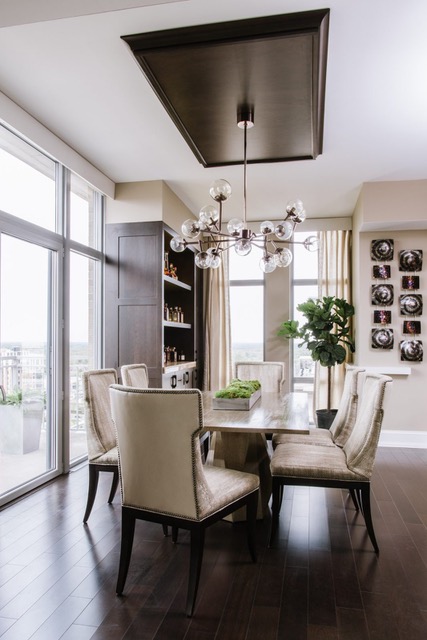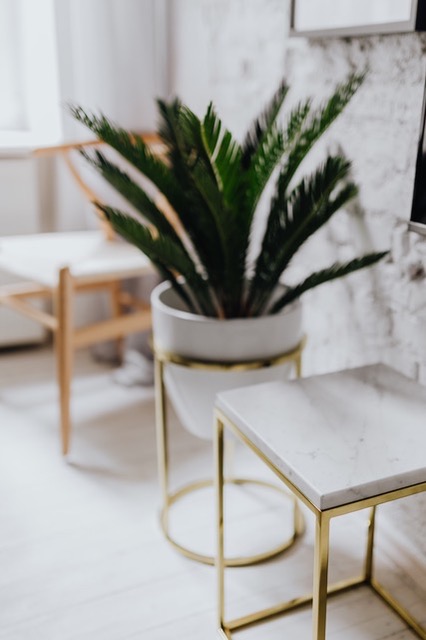My clients know that in nearly every space, I encourage the use of greenery in my designs. Including something “alive” in an area that often consists of hard surfaces adds not just warmth but a feeling of comfort you only get from nature. Did you know that having plants in your home is good for your health because they can help remove up to 87% of airborne toxins?
Not only are houseplants good for your health, but they can also help to transform your living space and make a room feel warmer and look more complete.
Keep reading to learn more about how plants in interior design can help to elevate the design of your home.
How to Update Your Home With Houseplants

Incorporating plants into the interior design of your home can help improve your mental health, boost your immune system, and even make you more productive.
In architecture, there is a concept called Biophilic Design, which aims to connect the interior occupant of a building to the outside environment by incorporating the natural world into building design, in essence bringing the outdoors inside.
Through extensive studies, it has shown to reduce stress, improve your cognitive function and well-being, enhance creativity, and help with clarity of thought. The concept can be applied to residential interior design and bringing nature into our indoor living spaces.

If you’re a nature lover and are looking for ways to refresh your interior design, then why not add some plants?
There are a great number of houseplants to choose from. Some are ideal for those who aren’t good at remembering to water, while others are better for those who want to add something unique to their home environment.
Where to Put Plants in Your Home
Though plants have been around for millennium, bringing them inside has become an integral part of interior design. How do you know where to put them? When it comes to deciding where to place plants in your home, there’s an abundance of possibilities.
You could place a well-selected plant or appropriately sized tree on the floor in a fabulous container. A unique container is a perfect addition to those empty spaces in your room that need a bit of decoration. Whether you have a home with all new furniture or want to add some interest to an existing area, adding a beautiful plant can add texture, lovely green foliage, and life.

Just make sure when you are selecting your plant that you are environmentally aware and choose the appropriate one for that space so that your plant has enough light and space to grow.
Intersperse a small plant on a bookshelf mixed with curated accessories or on a desk for added interest. Small house plants are great for adding a bit of character to parts of the room that usually get ignored, like on a console or cocktail table.
Let’s not forget the beauty of a fresh flower arrangement. Colorful, fresh flowers work wonderfully as a centerpiece on a dining table where they help to bring color, light, and a beautiful fragrance to a room.
Alternatively, you could choose a flowering houseplant such as a small rose or the designer favorite, an orchid. In a kitchen, place a series of three herbs in coordinating containers on your counter to soften the hard surfaces.

Designing With Plants: Which Plants Work Best?

Once you’ve decided where you want to place your plants, then it is time for a fun day of shopping at a local nursery to determine which plants you want to bring home. With so many plants to choose from, how do you know which ones will best complement your home?

The first consideration is your home’s style. If you have a southwestern, causal feel, then a cactus or succulent would be appropriate. If you have a more contemporary style home, then a Yucca Cane plant might be the way to go. Orchids and Fiddle-Leaf Fig trees are good with all design styles but come with care instructions.
Once you have determined your style, then you must consider the container that coordinates with your interior style, the plant that goes into it, and the other pieces in the surrounding area.
As an example, for a contemporary or southwestern style, look for a container that is a glass terrarium or elongated stone bowl as possible options.
A third very important factor in deciding what plants to bring into your home is scale.
Think of the same principle as when designing with fabrics where you don’t want all of the patterns to be the same size, the same holds true for plant foliage.
Mix up the leaf sizes from a large-leafed tree, a thin and pointy floor plant to the small delicate leaves like on a MaidenHair fern. This adds visual interest where nothing is fighting for attention, but all are complementing one another.
Interior design is all about coming up with innovative ways that can transform the way you live.
What Type of Plants Create a Warm Living Space? Here are 5 Favorites
Almost all plants can help to create a feeling of warmth and a bond with nature, so if you have a favorite plant, then consider bringing it into your home.
Keep in mind that like with most things, less is more, and that goes with plants as well. Be judicious in your placement and the number of plants you use. Too many, and you will feel like you have created a nursery with a lot of upkeep and care, which will add stress.
Just enough and well placed will help to create a tranquil and peaceful environment. These are some of our favorite plants that you might want to take a closer look at on your day at the nursery:
Maidenhair Fern:
The Maiden Hair Fern is the perfect plant for small spaces. The leaves are lacy and airy with slender black stems. Put in a beautiful container, and it adds warmth to any space.
The catch, do not let it dry out, water, water, water. Don’t fret if you see a frond die, as long as you are diligent with watering a new shoot will emerge. If you remember to give a little water when you enjoy your morning beverage, you will be rewarded with an elegant, happy, lush little fern.
Chinese Money Plant:
I just adore this darling little plant, whose Latin name is Pilea Peperomioides.
With its straight stems, and leaves that look like giant green coins. They are happy in diffused light, and you only have to water them once a week.
These beautiful plants were first brought to my attention by a magazine stylist; afterward, I just had to get one in my own home.
This plant is a great small plant that grows to be about 10 to 12 inches in height. You can liven it up with a beautiful container to match the aesthetic of your home.

Snake Plant:
Don’t let the nick-name it goes by, “mother-in-law’s tongue” scare you off.
The leaves are long, straight, and pointy, with an interesting pattern. The snake plant is a very upright plant that has unique air-purifying qualities. However, it does prefer a bit of dryer soil and moderate light.
Choose this plant for those tighter spaces where you want something thin and medium height. Looks great in a raised-stand container. Best of all, one of the hardest plants to kill!

Bird-of-Paradise:
Bird of Paradise is an excellent option for a large plant that is tree-like. This plant is multi-stemmed, bright green, and it gives way to an exciting shape for interior design.
Make sure you give this shrub direct, bright light, and water once or twice a week. It looks wonderful behind a sofa in a condo with loads of windows where it adds height, interest and can serve as an organic privacy screen.
What article would be complete without the designer favorite:
Fiddle-Leaf Fig Tree:
Without a doubt, the designer favorite and included in so many interior spaces you see photographed is the Fiddle-Leaf Fig Tree.
Understandably so, with its large scale leathery, deep green leaves and substantial presence. Offerings range from single trunk versions that are up to 7 and 8 feet, to lower 3′ multi-stemmed versions.
Beware, however, they are terribly temperamental. As a tropical rainforest plant, they require particular conditions. Let’s face it we live in Washington, DC – not Hawaii.
They do not tolerate drafts, soil that is either too wet or too dry, they don’t like direct sun, or dry air; the list goes on. So why all the uproar and why are they the design “it” plant?
Because of those fabulous deep green, large scale, unusual leaves we all can’t live without. I do have one in my own home and use them in my design, but they are not for every home, or every client, or the faint of heart.

Create a Warmer Living Space with Plants in Design

There are many factors to consider when using plants in design to transform your living spaces; however, by doing so, your home will feel warmer, brighter, and more personal.
Keep in mind, restraint in the quantity, the importance of a special container, and to always consider the needs of your plants to ensure that you care for them properly.

Looking for an interior designer?
Book your discovery call with Syntha Harris to discuss your design ideas and to find out how you can create a greener and more organic living space.





